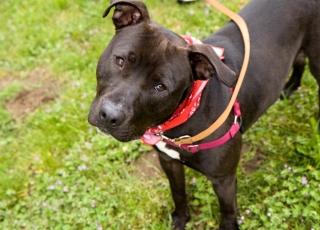Play Provides Enrichment for Shelter Dogs

At the beginning of May I started an amazing adventure with Multnomah County Animal Services in Troutdale, OR. This Open Paw shelter asked if I would be interested in running a shelter play group program to provide further enrichment for their canine guests. You bet I would!
I've had years of experience with off-leash dog play, but this was going to be something very different. Remember, we often have no idea of a dog's history before it reaches the shelter. In dog daycare or group classes we have humans who can often tell us everything about their dog's experiences from the beginning of their dog's life. Shelter dogs can't sit down and tell us what they know, where they've been and if they are going to be friendly in a play group.
Additionally, anyone who works with shelter dogs knows that these are dogs under stress. The situation is more stressful for some than others, and the reactions to stress vary from dog to dog. Thankfully, people like Stephanie Collingsworth in Behavior and Training at MCAS understand this completely. It is Stephanie's job to assess behavior and adoptability of the dogs in the shelter. She understands that some dogs need more time than others to adjust. She knows that assessment can't be rushed and sometimes has to be re-visited over time. Because MCAS is so careful and patient with the dogs in their care, they understand that the play group process can't be rushed either.
The process for evaluating play group readiness begins with volunteers walking the kennels with me as we read about each dog, share insights (many of the volunteers are also dog walkers with previous experiences with most of the dogs), and assess any kennel presentation issues. This means, dogs who are painfully shy or ultra-nervous. These dogs aren't ruled out, but we do make note of any dogs who might have special handling needs.
Since the first day of play groups, we established a core group of dogs who we know are friendly to most other dogs. Because of the shelter environment, our core group changes quickly...and we WANT that! Dogs don't stay at MCAS for very long. They are adopted, fostered or taken in by rescue groups constantly. (I'm sincerely impressed with the short stays and volume of adoptions!) So, our core group is always losing a few and gaining a few, but we do have a core group.
*Sidenote: The dog in the photo has been part of our core group for too long. He's awesome with all the other dogs and so responsive to us humans, but it's time he find a home! If you're interested, visit the MCAS website for more info on Spike.
We start off with the core group, even if it's only one or two dogs that day. We have them in the "first yard". There are two play yards with adjoining fences and several gates. We bring the first new evaluation dog into the empty play yard and watch it's behavior very closely. Is the dog interested in the other dogs? Too interested? Too aroused? How is the core group reacting to the new dog?
We don't rule out a dog for over-arousal at the gate. We simply take note of it. If it's way over the top we will work with the dog from the other side of the fence getting him used to doing recalls and sits in the presence of other dogs. This might be as far as we get with a particular dog on that day, and that's okay.
If we decide to proceed, it's time for what we call an "on-leash drive-by". One of the core group dogs and the new dog are put on-leash. All other dogs are crated. We bring them both into the same yard but keep them at a distance. We check to see that each dog can look to their handler for a treat. This is very important to me. I want to know that the dogs are not so over-aroused that they can't stop to pay attention to the humans. If all is well, we move closer.
We continue moving closer, allow some quick nose to nose, move away and pay attention to humans, meet the other dog a bit longer. Still going well? Loose leashes, circling, butt sniffs. If we get some play bows and overt play solicitation, we may drop the leashes and let the dogs play. If that goes well, we'll add in another core group dog.
The tricky part is that it might go this way, and it might not. There are too many details and variables to cover it all in one post. That's why I'll be doing a lot of video taping and blogging about individual dogs and situations. For now, I've posted a video of Lenny joining our core group of Cassie, Penelope and Honey. Lenny had done so well at the gate with these girls that he was simply let in with his leash dragging. More to come!




